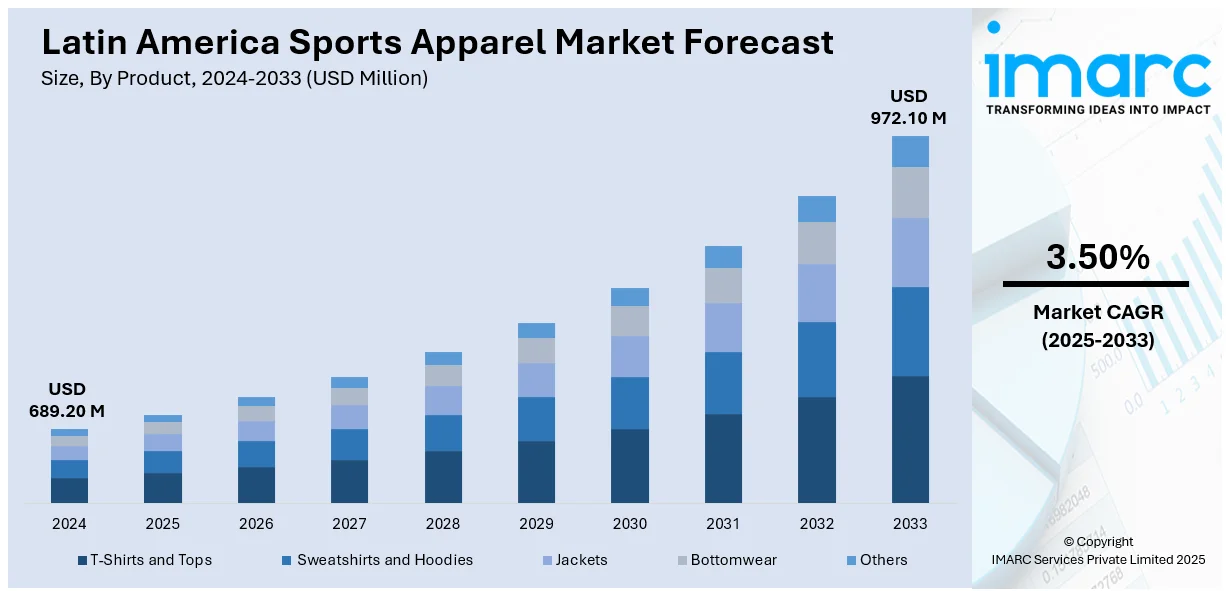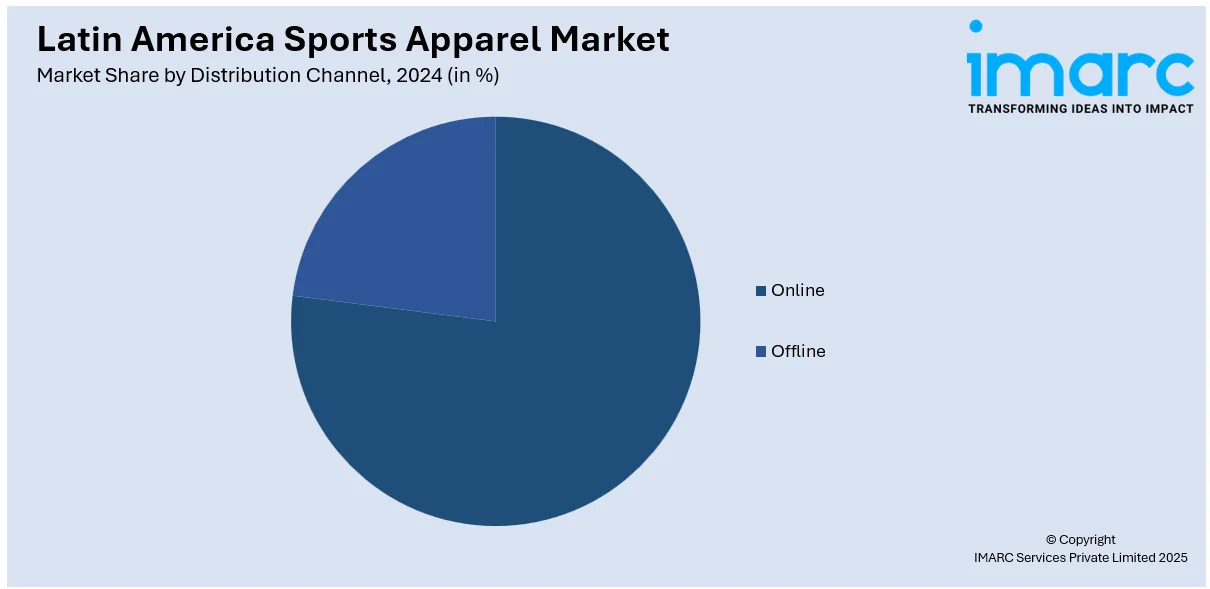
Latin America Sports Apparel Market Size, Share, Trends and Forecast by Product, Distribution Channel, and Region, 2025-2033
Latin America Sports Apparel Market Overview:
The Latin America sports apparel market size reached USD 689.20 Million in 2024. Looking forward, IMARC Group expects the market to reach USD 972.10 Million by 2033, exhibiting a growth rate (CAGR) of 3.50% during 2025-2033. The rising health consciousness, increasing participation in fitness activities, growing influence of athleisure trends, expanding e-commerce penetration, endorsement by athletes, advancements in fabric technology, demand for sustainable materials, and a strong preference for international and local brands s expanding the Latin America sports apparel market share.
|
Report Attribute
|
Key Statistics
|
|---|---|
|
Base Year
|
2024
|
|
Forecast Years
|
2025-2033
|
|
Historical Years
|
2019-2024
|
| Market Size in 2024 | USD 689.20 Million |
| Market Forecast in 2033 | USD 972.10 Million |
| Market Growth Rate (2025-2033) | 3.50% |
Latin America Sports Apparel Market Trends:
Rise of Sustainable and Eco-Friendly Sports Apparel
The Latin America sports apparel market growth is driven by rapid shift towards sustainability, driven by increasing consumer awareness and demand for eco-friendly products. For instance, according to industry reports, Brazil is becoming a pioneer in sustainable packaging, which can be accredited to advancements like PEGreen, a plant-based plastic, and ESG guidelines. Its expanding worldwide influence in 2025 will be shaped by eco-friendly materials and smart packaging. In order to satisfy consumer and environmental expectations, the packaging business is striking a balance between history and modern technology. Another important factor in raising customer engagement is the use of visuals in branding and product presentation. Brands are also incorporating recycled materials, organic cotton, and biodegradable fabrics into their product lines, aligning with global sustainability goals. Leading companies are investing in innovative production techniques, such as waterless dyeing and reduced carbon emissions, to appeal to environmentally conscious consumers. Additionally, several government initiatives promoting sustainable manufacturing and ethical labor practices are further accelerating this trend. Consumers, particularly millennials and Gen Z, are prioritizing apparel that balances performance with sustainability, prompting brands to focus on transparency and ethical sourcing. With the rise of eco-conscious consumerism, the demand for sustainable sports apparel is expected to continue growing, influencing market strategies and product innovations across the region. This shift underscores the industry's commitment to environmental responsibility while meeting the evolving preferences of Latin American athletes and fitness enthusiasts.

Growing Influence of Athleisure and Everyday Sportswear
Athleisure is rapidly transforming the Latin American sports apparel market, blurring the lines between activewear and casual fashion. Consumers increasingly seek versatile sportswear that provides comfort, style, and performance, driving demand for multipurpose athletic clothing. The post-pandemic shift towards health-conscious lifestyles and remote work has accelerated the adoption of sports apparel as daily wear. Major brands are capitalizing on this trend by launching collections that combine high-performance fabrics with stylish designs suitable for both workouts and casual outings. Furthermore, social media influencers, sports personalities and fitness enthusiasts are playing a key role in popularizing athleisure, influencing purchasing decisions among younger demographics. Notably, Adidas Originals announced a unique collaboration between music superstar Bad Bunny and soccer legend Lionel Messi. The Bad Bunny & Messi Collection celebrates the connection between music and sport, paying tribute to the legacies of both stars, with the collection landing in adidas stores and online on October 26, 2024. The collection is inspired by adidas' heritage models and features two iconic silhouettes: the adidas Gazelle and the adidas F50 cleat, the latter being a shoe Messi has worn throughout his career. Apart from this, local and international brands are responding by expanding their athleisure offerings, incorporating moisture-wicking materials, seamless designs, and customizable fits, which in turn is positively impacting the Latin America sports apparel market outlook. As consumer preferences continue evolving, the athleisure trend is expected to shape the future of Latin America’s sports apparel market, driving innovation and growth across the industry.
Latin America Sports Apparel Market Segmentation:
IMARC Group provides an analysis of the key trends in each segment of the market, along with forecasts at the regional level for 2025-2033. Our report has categorized the market based on product and distribution channel.
Product Insights:
- T-Shirts and Tops
- Collegiate
- Non-Collegiate
- Sweatshirts and Hoodies
- Collegiate
- Non-Collegiate
- Jackets
- Collegiate
- Non-Collegiate
- Bottomwear
- Collegiate
- Non-Collegiate
- Others
The report has provided a detailed breakup and analysis of the market based on the product. This includes t-shirts and tops (collegiate and non-collegiate), sweatshirt and hoodies (collegiate and non-collegiate), jackets (collegiate and non-collegiate), bottomwear (collegiate and non-collegiate), and others.
Distribution Channel Insights:

- Online
- Offline
- Supermarkets and Hypermarkets
- Specialty Stores
- Campus Bootstores
- Others
A detailed breakup and analysis of the market based on the distribution channel have also been provided in the report. This includes online and offline (supermarkets and hypermarkets, specialty stores, campus bootstores and others).
Regional Insights:
- Brazil
- Mexico
- Argentina
- Colombia
- Chile
- Peru
- Others
The report has also provided a comprehensive analysis of all the major regional markets, which include Brazil, Mexico, Argentina, Colombia, Chile, Peru, and others.
Competitive Landscape:
The market research report has also provided a comprehensive analysis of the competitive landscape. Competitive analysis such as market structure, key player positioning, top winning strategies, competitive dashboard, and company evaluation quadrant has been covered in the report. Also, detailed profiles of all major companies have been provided.
Latin America Sports Apparel Market News:
- On December 9, 2024, the Brazilian Football Confederation (CBF) and Nike signed a 12-year renewal, which would now run through 2038. The CBF is able to license products and open stores globally for the first time thanks to this extended arrangement, which is worth USD 100 million a year plus royalties from jersey sales. All Brazilian national teams, including the men's, women's, beach soccer, and futsal teams, will continue to use Nike as their official uniform provider.
- On 30 January 2025, Nike signed an endorsement deal with Brazilian surfer Ítalo Ferreira, marking its return to the sport, with the Nike logo to feature on Ferreira’s surfboard and the athlete to wear various Nike apparel.
Latin America Sports Apparel Market Report Coverage:
| Report Features | Details |
|---|---|
| Base Year of the Analysis | 2024 |
| Historical Period | 2019-2024 |
| Forecast Period | 2025-2033 |
| Units | Million USD |
| Scope of the Report |
Exploration of Historical Trends and Market Outlook, Industry Catalysts and Challenges, Segment-Wise Historical and Future Market Assessment:
|
| Products Covered |
|
| Distribution Channels Covered |
|
| Regions Covered | Brazil, Mexico, Argentina, Colombia, Chile, Peru, Others |
| Customization Scope | 10% Free Customization |
| Post-Sale Analyst Support | 10-12 Weeks |
| Delivery Format | PDF and Excel through Email (We can also provide the editable version of the report in PPT/Word format on special request) |
Key Questions Answered in This Report:
- How has the Latin America sports apparel market performed so far and how will it perform in the coming years?
- What is the breakup of the Latin America sports apparel market on the basis of product?
- What is the breakup of the Latin America sports apparel market on the basis of distribution channel?
- What is the breakup of the Latin America sports apparel market on the basis of region?
- What are the various stages in the value chain of the Latin America sports apparel market?
- What are the key driving factors and challenges in the Latin America sports apparel?
- What is the structure of the Latin America sports apparel market and who are the key players?
- What is the degree of competition in the Latin America sports apparel market?
Key Benefits for Stakeholders:
- IMARC’s industry report offers a comprehensive quantitative analysis of various market segments, historical and current market trends, market forecasts, and dynamics of the Latin America sports apparel market from 2019-2033.
- The research report provides the latest information on the market drivers, challenges, and opportunities in the Latin America sports apparel market.
- Porter's five forces analysis assist stakeholders in assessing the impact of new entrants, competitive rivalry, supplier power, buyer power, and the threat of substitution. It helps stakeholders to analyze the level of competition within the Latin America sports apparel industry and its attractiveness.
- Competitive landscape allows stakeholders to understand their competitive environment and provides an insight into the current positions of key players in the market.
Need more help?
- Speak to our experienced analysts for insights on the current market scenarios.
- Include additional segments and countries to customize the report as per your requirement.
- Gain an unparalleled competitive advantage in your domain by understanding how to utilize the report and positively impacting your operations and revenue.
- For further assistance, please connect with our analysts.
 Inquire Before Buying
Inquire Before Buying
 Speak to an Analyst
Speak to an Analyst
 Request Brochure
Request Brochure
 Request Customization
Request Customization




.webp)




.webp)












